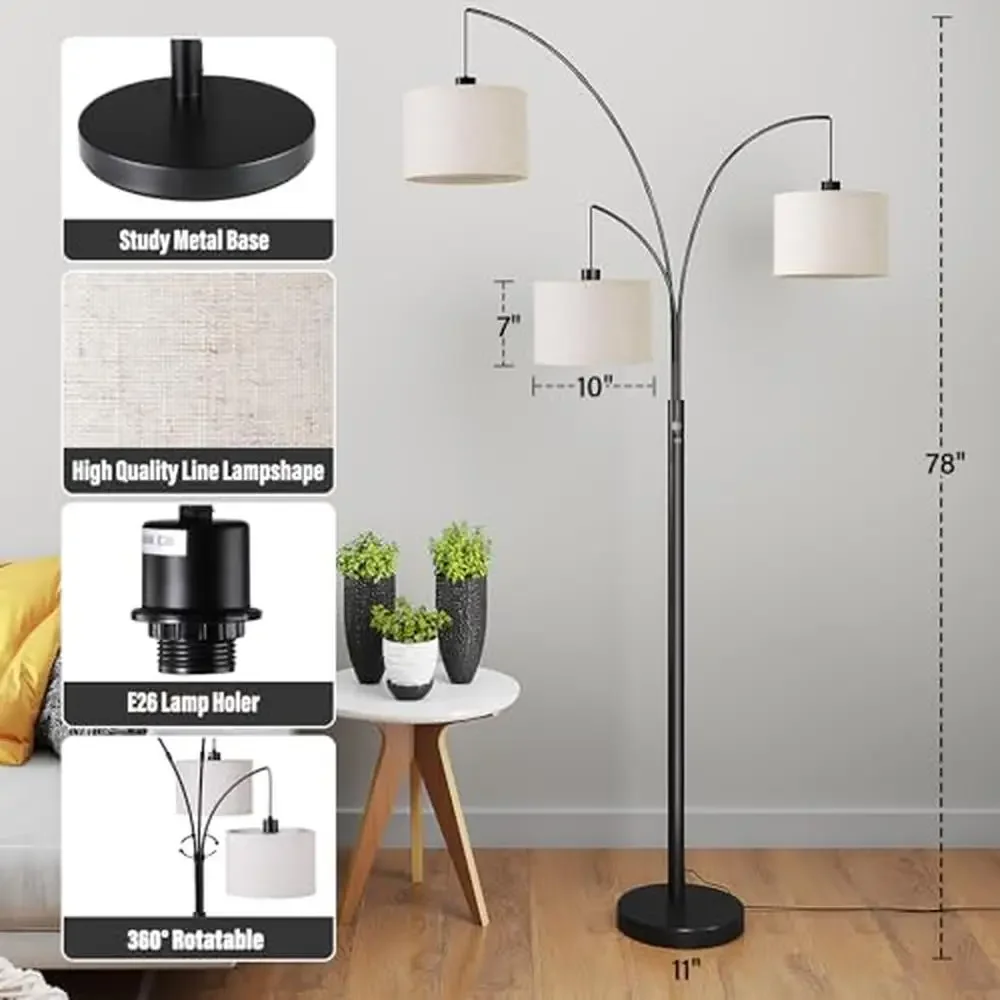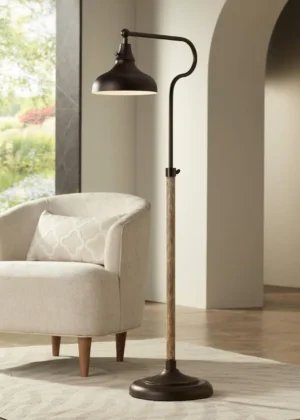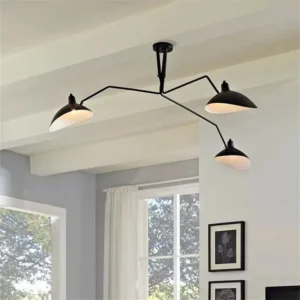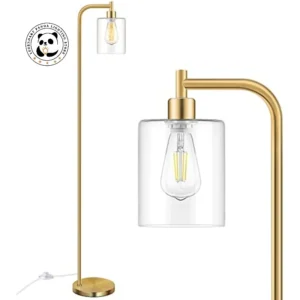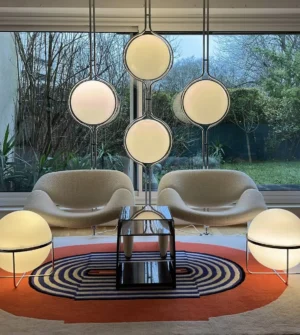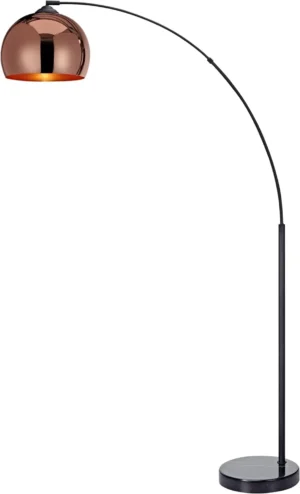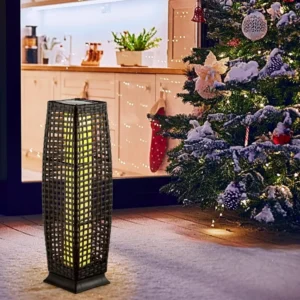Understanding Multi-Arm Arc Lamps
Multi-arm arc lamps are distinctive lighting fixtures characterized by multiple adjustable arms that extend gracefully from a single base, with each arm housing its own independent light source. Unlike standard floor lamps that offer only a single light point, these sophisticated fixtures combine remarkable functionality with stunning aesthetic appeal, making them both practical lighting solutions and striking design elements.
What truly sets multi-arm arc lamps apart is their ability to provide customizable illumination. Each arm can be adjusted independently, allowing you to direct light precisely where needed. This versatility makes them a premium lighting solution for discerning homeowners who understand that proper lighting isn’t just about brightness—it’s about creating layers of light that add dimension and atmosphere to a space.
The concept of light layering is central to understanding the value of multi-arm arc lamps. By positioning each arm strategically, you can simultaneously address different lighting needs within a single area—something that would typically require multiple standard lamps. This efficiency doesn’t come at the expense of style; in fact, these lamps often serve as sculptural focal points that elevate the overall design of a room.
When comparing multi-arm arc lamps to traditional single-arm designs, the difference becomes immediately apparent. While single-arm models provide focused illumination in one area, their multi-arm counterparts offer a symphony of light that can transform an entire room. Their carefully engineered features—from the weighted base that ensures stability to the precisely balanced arms that maintain position without drooping—reflect a sophisticated approach to choosing the perfect arc floor lamp for your space.
What Sets Multi-Arm Arc Lamps Apart
Multi-arm arc lamps offer several distinctive features that separate them from conventional lighting options:
• Independent Light Control: Each arm contains its own light source that can be controlled separately, allowing you to illuminate only the areas you need while leaving others dimmed or off entirely.
• Directional Flexibility: The adjustable arms can be positioned in virtually any direction simultaneously, creating customized lighting scenarios impossible with fixed fixtures.
• Sculptural Presence: Beyond their practical function, these lamps serve as architectural design elements that add visual interest even when not illuminated.
• Space Efficiency: A single multi-arm lamp can replace several traditional lamps, freeing up valuable floor space while providing more comprehensive lighting coverage.
• Lighting Versatility: From ambient room illumination to focused task lighting to dramatic accent highlighting, one fixture can address multiple lighting needs simultaneously.
The sophisticated functionality of these lamps often includes features like independent switches for each arm, stepless dimming capabilities, and memory settings that recall your preferred positions. Interior designers frequently incorporate these statement pieces into their projects not just for illumination but as anchoring elements that tie together entire design concepts.
The differences between single and multi-arm arc lamps become particularly important when considering how each might serve your specific lighting needs and space constraints.
The Investment Value of Multi-Arm Lighting
Investing in a high-quality multi-arm arc lamp represents long-term value that extends beyond the initial purchase. While the upfront cost may exceed that of basic lighting options, the versatility eliminates the need for multiple single-purpose lamps—creating both space efficiency and cost efficiency over time.
The adaptability of these fixtures cannot be overstated. As your room arrangements evolve and your lighting needs change, a multi-arm lamp can be reconfigured rather than replaced. This adaptability makes these lamps particularly valuable in dynamic living spaces where furniture is occasionally rearranged or rooms serve multiple functions.
From a design perspective, quality multi-arm arc lamps feature timeless aesthetics that transcend short-term trends. Their clean lines and functional elegance continue to enhance spaces long after more trendy lighting options have fallen out of favor. When equipped with modern LED technology, these lamps also deliver impressive energy efficiency, consuming significantly less electricity while providing superior illumination.
Many homeowners discover that arc floor lamps are good investments not only for their practical utility but also because they elevate the perceived value of an entire room. A thoughtfully selected lamp becomes a design anchor that enhances surrounding elements while providing essential illumination for years to come.
The Mechanics of Multi-Arm Arc Lighting
Understanding how multi-arm arc lamps function helps you maximize their potential in your space. These sophisticated fixtures rely on precise engineering to maintain both stability and adjustability. The graceful arcs are made possible through a system of counterweights housed in the base that balance the extending arms, allowing them to project outward without tipping.
The arms themselves feature carefully designed pivot joints that provide smooth movement while maintaining position once set. These joints typically offer three types of movement: horizontal swiveling, vertical angle adjustment, and in premium models, rotational positioning of the individual light heads. Some high-end designs even incorporate telescopic features that allow you to extend or retract the reach of specific arms.
Weight distribution is a critical aspect of multi-arm lamp design. The substantial base (often marble or heavy metal) counterbalances the extended arms to prevent tipping, even when the arms are positioned asymmetrically. This balance must be precisely calculated based on the number of arms, their maximum extension, and the weight of the light fixtures they support.
Movement mechanisms vary between models—some feature synchronized arm movement for maintaining relative positioning, while others offer completely independent adjustment for maximum customization. Premium designs ingeniously conceal these mechanical elements within sleek housing, maintaining clean lines despite the complex engineering within.
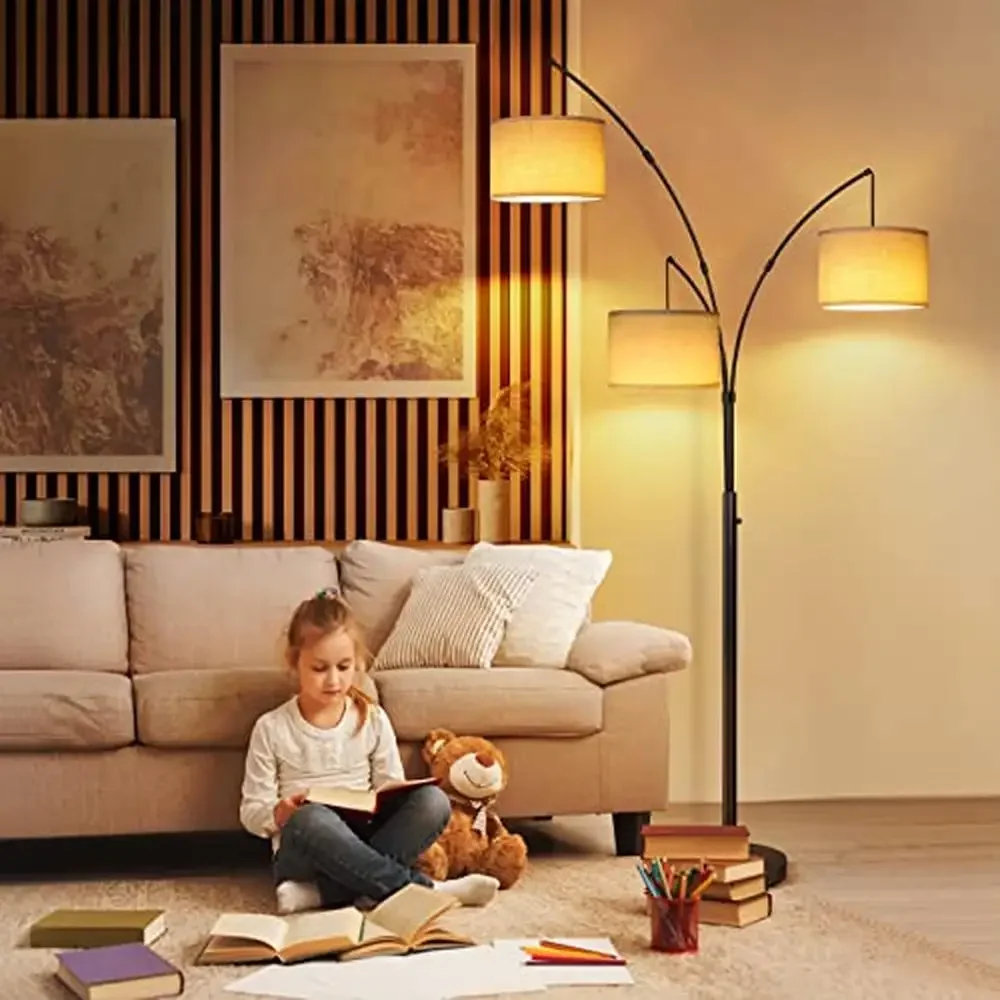
The most versatile adjustable arc floor lamps typically offer rotation ranges of 120-180 degrees horizontally and 30-45 degrees vertically, allowing for comprehensive coverage of living spaces from a single position.
Types of Light Delivery Systems
Multi-arm arc lamps employ various light delivery approaches, each creating different effects:
• Direct Light: Arms positioned to aim light directly downward create focused beams ideal for task lighting, reading, or highlighting specific objects. This approach maximizes brightness but can create sharp shadows.
• Indirect Light: By aiming light upward toward ceilings or walls, the beam reflects and diffuses throughout the space, creating soft, ambient illumination free from harsh shadows or glare.
• Diffused Light: Many arms include shades or diffusers that soften and spread light more evenly. Materials like frosted glass, fabric, or perforated metal transform harsh direct light into gentle illumination.
• Combination Lighting: The most sophisticated lighting scenarios utilize multiple arms to create layered effects—perhaps one arm for indirect ambient light, another for direct task lighting, and a third for accent highlights.
• Directional Control: The physical design of each arm’s head—whether it’s a narrow spotlight, wide floodlight, or diffused globe—fundamentally affects how light distributes through your space.
Modern 3-light arc floor lamps typically deliver between 400-800 lumens per head, providing ample illumination for most residential applications. The flexibility to combine these different light delivery methods in a single fixture is what makes multi-arm lamps so versatile compared to conventional lighting options.
Essential Multi-Arm Arc Lamp Lighting Techniques
Mastering multi-arm arc lamp lighting techniques allows you to transform your space with sophisticated illumination that addresses both practical needs and aesthetic goals. The following section explores four fundamental approaches that interior designers regularly employ when working with these versatile fixtures.
At the heart of effective multi-arm lamp usage is the concept of light layering—creating depth and dimension by combining different types of light within the same space. Rather than relying on a single overhead light source that flatly illuminates a room, layered lighting creates visual interest, highlights architectural features, and adapts to different activities and moods.
Professional designers approach lighting as a composition, with each light source playing a specific role in the overall effect. The techniques that follow can be used independently for simple applications or combined for more complex lighting scenarios. Understanding these principles helps you maximize the value of your multi-arm lamp and create truly customized lighting for your space.
Learning how multi-arm floor lamps light a room effectively requires understanding these fundamental techniques and applying them thoughtfully to your specific space.
Creating Versatile Ambient Lighting
Ambient lighting provides general illumination that fills a room with soft, even light. Multi-arm arc lamps excel at this function when properly positioned:
To create balanced ambient lighting, position two or three arms at different heights, angled slightly upward toward walls or ceilings. This technique bounces light off surfaces, diffusing it throughout the space while minimizing harsh shadows. The reflection creates a gentle glow that feels natural and inviting.
For rooms with higher ceilings, direct one arm straight upward to cast light on the ceiling, creating the impression of greater height and airiness. In rooms with standard-height ceilings, angle arms toward walls instead to prevent uncomfortable overhead glare.
Layered ambient lighting creates depth by placing arms at varying heights—perhaps one at 5 feet (1.5 meters), another at 6 feet (1.8 meters), and a third at 7 feet (2.1 meters)—each contributing to the overall room illumination while creating subtle variations in brightness.
For evening relaxation, direct arms toward room corners at medium brightness, creating a gentle perimeter glow that doesn’t overwhelm. When entertaining, reposition the arms more centrally and increase brightness to energize the space.
Frosted or opal glass shades work particularly well for ambient applications, diffusing light evenly without noticeable hot spots. Warm white bulbs (2700K-3000K) enhance the cozy atmosphere perfect for living areas and bedrooms.
For more nuanced control over the ambiance of your space, arc floor lamps for mood lighting provide the flexibility needed to create the perfect atmosphere for any occasion.
Mastering Specific Task Lighting
Task lighting focuses illumination on specific areas where detailed activities occur, such as reading, working, or hobbies:
For optimal reading light, position one arm approximately 18-24 inches (45-60 cm) from your reading material, angled to direct light onto the page without casting shadows from your head or shoulders. The ideal position is slightly behind and to one side of your shoulder.
When working at a desk, position an arm to shine from the opposite side of your dominant hand to prevent shadows across your workspace. The light should be bright enough for detail work but not so intense it creates screen glare if you’re using a computer.
To eliminate shadows entirely, use two arms positioned at opposite angles—this creates balanced cross-lighting that minimizes dark areas, ideal for detailed tasks like sewing, crafting, or art projects.
For shared spaces where different people need task lighting without disturbing others, adjust individual arms to create personal lighting zones. One person can enjoy bright, focused light for reading while others in the room remain in softer ambient lighting.
Task lighting benefits from cooler color temperatures (3500K-4000K) that enhance contrast and clarity. Look for LED arc floor lamps that provide bright, energy-efficient illumination without producing excessive heat—allowing for comfortable extended use during lengthy tasks.
Highlighting with Accent Lighting
Accent lighting draws attention to specific objects or architectural features, creating visual interest and depth:
To highlight artwork effectively, position an arm approximately 30 inches (75 cm) from the wall, angled at about 30 degrees toward the piece. This creates a focused pool of light that makes colors more vibrant and textures more pronounced.
For showcasing three-dimensional objects like sculptures or indoor plants, position two arms at 45-degree angles from different sides to create subtle cross-lighting that reveals form and texture while minimizing harsh shadows.
Use accent lighting to add depth to room corners by directing a single arm toward the intersection of walls. This simple technique prevents corners from appearing dark and flat, making rooms feel more spacious and inviting.
Create visual hierarchy by highlighting your room’s most important elements with brighter accent lighting while using softer illumination for secondary features. This guides the eye naturally through the space and establishes focal points.
When using accent lighting, balance it with ambient illumination to prevent excessive contrast. The general rule is that accent lighting should be approximately three times brighter than the surrounding ambient light—enough to draw attention without creating jarring brightness differences.
Defining Zones Within Open Spaces
Multi-arm arc lamps excel at creating visual boundaries in open floor plans without physical dividers:
To establish distinct functional areas, position arms to create pools of light that define different zones—brighter, more focused light over a reading area contrasted with softer, diffused light over conversation spaces creates clear visual boundaries.
For conversation areas, position arms to create a circle of light that encompasses the seating arrangement, psychologically drawing people together while separating this zone from surrounding spaces.
In multipurpose rooms, use different lighting temperatures to subtly distinguish zones—warmer light (2700K) for relaxation areas and cooler light (3500K) for work spaces helps transition mentally between activities despite being in the same room.
Create implied pathways by positioning arms sequentially, guiding movement through the space with subtle lighting cues rather than physical barriers.
In studio apartments, use dramatic differences in light intensity to separate sleeping areas from living spaces—dimmer, indirect lighting signals rest while brighter, more direct illumination energizes activity areas.
Exploring how multi-arm arc lamps work in open-plan spaces can provide additional insights for effectively dividing larger areas using strategic lighting techniques.
Optimal Placement and Positioning
Strategic placement of your multi-arm arc lamp is crucial for maximizing both its functional benefits and aesthetic impact. The ideal position balances practical lighting needs with the lamp’s role as a design element, while considering the architectural features and traffic flow of your space.
When determining placement, first identify the primary lighting needs in the area—whether ambient illumination, task lighting for specific activities, or accent lighting for architectural features. This purpose should drive your initial positioning decisions.
Room layout significantly influences optimal lamp placement. Consider ceiling height, window positions, existing light sources, and furniture arrangement when selecting the perfect spot. The lamp should complement these elements rather than compete with them.
While multi-arm lamps are versatile, they do require adequate space to function properly. Allow at least 12-18 inches (30-45 cm) of clearance around the base and ensure the arcs won’t interfere with walkways or head clearance. Room corners often provide ideal positioning, allowing the arms to extend into the space without creating obstacles.
The following sections explore specific room applications, each with unique considerations for optimal multi-arm lamp placement.
In Living Room Settings
The living room offers numerous opportunities for strategic multi-arm arc lamp placement:
Position your lamp beside a sectional sofa with the base tucked behind or beside the furniture and arms extending over the seating area. This creates functional lighting while minimizing floor space usage. For optimal reading conditions, position one arm approximately 24 inches (60 cm) above and 10 inches (25 cm) to the side of your typical reading position.
In rooms lacking overhead lighting, place a multi-arm lamp centrally with arms radiating outward to provide balanced general illumination. This approach distributes light more evenly than traditional floor lamps and eliminates the need for ceiling wiring.
For conversation areas featuring multiple seating pieces, position the lamp where its arms can extend over different seating options, providing appropriate light for each person. This creates a unified lighting experience despite the distributed seating arrangement.
To create a dedicated reading nook within a larger living space, position the lamp with its base behind the chair and one arm extending directly over the seating. Other arms can be directed toward nearby walls for ambient reflection or to highlight adjacent artwork or shelving.
When balancing the lamp with other furniture, follow the designer’s rule of thirds—ideally, the lamp’s height should be approximately two-thirds the height of the tallest nearby furniture piece for visual harmony.
Discovering the best arc lamps for living rooms can help you select the perfect model that balances form and function for your specific space.
For Bedroom Illumination
Multi-arm arc lamps offer creative alternatives to traditional bedroom lighting solutions:
Position a multi-arm lamp between two nightstands with arms extending over each side of the bed to replace traditional bedside lamps. This frees up nightstand surface space while providing targeted reading light for both sides of the bed.
For creating intimate lighting zones, place the lamp in a corner with one arm directed downward over a reading chair, another providing soft uplighting for ambient illumination, and a third highlighting artwork or architectural features.
In smaller bedrooms, position the lamp base against a wall with arms extending outward rather than a central placement that would consume valuable floor space. This approach maintains functionality while acknowledging spatial constraints.
For morning and evening transitions, program different brightness levels (if your lamp includes dimming features) or adjust arm positions—brighter, more direct light for morning routines and softer, indirect light for evening relaxation.
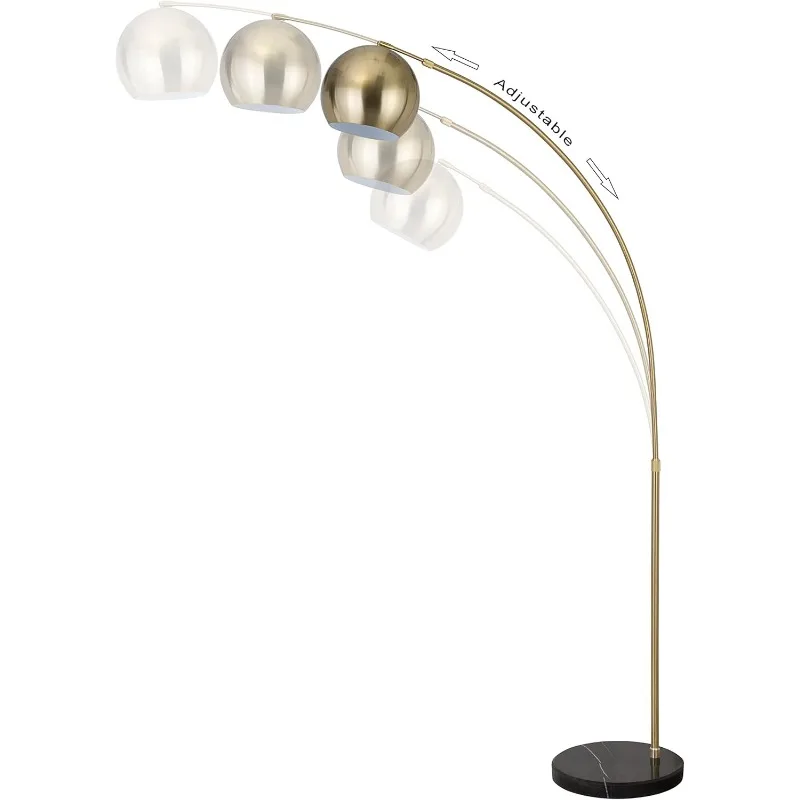
Consider dimmable arc floor lamps for bedrooms to allow easy brightness adjustments from energizing morning light to relaxing evening ambiance without repositioning the fixture.
Optimizing Home Office and Study Spaces
Proper lighting is crucial for productivity and eye comfort in home offices and study areas:
Position your multi-arm lamp to eliminate monitor glare by placing it perpendicular to your screen rather than behind or directly opposite it. One arm should provide indirect ambient light while another delivers task lighting from the side opposite your writing hand.
For video conference lighting, position one arm to provide soft front-facing light that illuminates your face without harsh shadows or overexposure. Angle the light slightly above eye level for the most flattering and professional appearance.
Create dual-purpose lighting by positioning one arm for detailed desk work and another for comfortable reading in an adjacent chair, allowing the space to transition easily between computer work and analog tasks.
To reduce eye strain during extended work sessions, use one arm for direct task lighting and another for ambient background light to minimize contrast between your work surface and surroundings. This balanced approach reduces the eye fatigue that comes from constantly adjusting between brightness extremes.
As natural light changes throughout the day, reposition arms to maintain consistent illumination—perhaps moving from reliance on natural light supplemented by gentle fill lighting in the morning to stronger direct illumination as daylight fades.
Brass arc floor lamps offer a professional aesthetic that works particularly well in home office settings, combining functionality with a sophisticated appearance appropriate for video calls and client meetings.
For Dining Areas and Entryways
Multi-arm arc lamps can transform dining areas and entryways with strategic placement:
For dining table illumination without fixed ceiling fixtures, position the lamp base adjacent to the table with arms extending over the dining surface. Ideal height is approximately 30-36 inches (75-90 cm) above the table surface—low enough to provide adequate illumination but high enough to prevent visual obstruction across the table.
Create dramatic entryway statements by positioning a multi-arm lamp near the entrance with one arm highlighting a console table or key piece of artwork while another provides general illumination for the space. This layered approach creates depth and visual interest from the moment someone enters your home.
Define entryway transitions by using targeted lighting to create a visual pathway—position arms to illuminate the route from entrance to main living area, subtly guiding visitors through the space.
For highlighting architectural features in transition spaces, direct individual arms toward elements like exposed beams, interesting stairways, or textured walls. This draws attention to the home’s character while providing functional illumination.
Balance the lamp’s statement design with practical needs by selecting a model whose scale complements the space—larger entryways can accommodate more dramatic designs, while smaller spaces benefit from more compact proportions with the same functional benefits.
Adjustable Arc Floor Lamp, Bronze Arc Floor Lamp
Price range: $440.95 through $558.52 Select options This product has multiple variants. The options may be chosen on the product page- Price range: $174.28 through $658.31 Select options This product has multiple variants. The options may be chosen on the product page
Brass Arc Floor Lamp, Contemporary Arc Floor Lamp, LED Arc Floor Lamp
Price range: $490.72 through $522.04 Select options This product has multiple variants. The options may be chosen on the product pageChrome Arc Floor Lamp, LED Arc Floor Lamp
Price range: $304.95 through $1,210.40 Select options This product has multiple variants. The options may be chosen on the product pageContemporary Arc Floor Lamp, Large Arc Floor Lamp, Marble Base Arc Floor Lamp
$224.94 Select options This product has multiple variants. The options may be chosen on the product pageLED Arc Floor Lamp, Rattan Arc Floor Lamp
$313.58 Select options This product has multiple variants. The options may be chosen on the product page
Integrating Multi-Arm Arc Lamps into Your Design
Successfully incorporating a multi-arm arc lamp into your interior design requires thoughtful consideration of both form and function. These striking fixtures serve dual purposes—providing essential illumination while simultaneously acting as sculptural design elements that contribute to your room’s overall aesthetic.
When selecting a multi-arm lamp, consider how its design language corresponds with your existing interior style. The lamp’s lines, materials, and proportions should complement rather than clash with your primary design direction. A highly ornate lamp may feel out of place in minimalist surroundings, while an ultra-modern design might seem jarring in a traditionally styled room.
The visual weight of multi-arm lamps must be carefully balanced within the space. Their arching forms occupy significant visual space even when their physical footprint is modest. In design terms, place these lamps where they can “breathe”—allowing enough surrounding space for their dramatic silhouettes to be appreciated without overwhelming neighboring elements.
Material choices affect both the quality of light produced and how the lamp integrates visually. Metallic finishes reflect surrounding colors and light, while matte finishes tend to recede visually. Similarly, transparent or translucent shades create different light dispersal patterns than opaque options, influencing both illumination quality and aesthetic impact.
Understanding how to harmonize arc lamps with interior design principles ensures these statement pieces enhance rather than disrupt your carefully curated space.
Matching Style and Aesthetics
Different lamp styles complement specific interior design approaches:
For modern and contemporary interiors, look for multi-arm lamps with clean lines, minimal ornamentation, and materials like brushed nickel, chrome, or matte black. These designs feature simple geometric forms that harmonize with contemporary spaces while providing sophisticated functionality.
Mid-century modern inspired spaces pair beautifully with arc lamps featuring gentle curves, warm metallic finishes like brass or copper, and walnut or teak accents. Look for designs with subtle retro influences rather than overt reproductions.
Industrial and minimalist interiors benefit from lamps with exposed mechanical elements, raw materials, and utilitarian forms. Black metal finishes, visible joints, and straightforward construction complement these more austere design approaches.
For transitional spaces that blend traditional and contemporary elements, choose lamps with classic proportions but updated materials and finishes. Designs that reference traditional forms while incorporating modern functionality bridge different design periods effectively.
The lamp’s silhouette contributes significantly to room composition—consider whether your space needs vertical emphasis (taller, more dramatic arcs) or horizontal movement (wider, lower-profile arms) to complement existing architectural features.
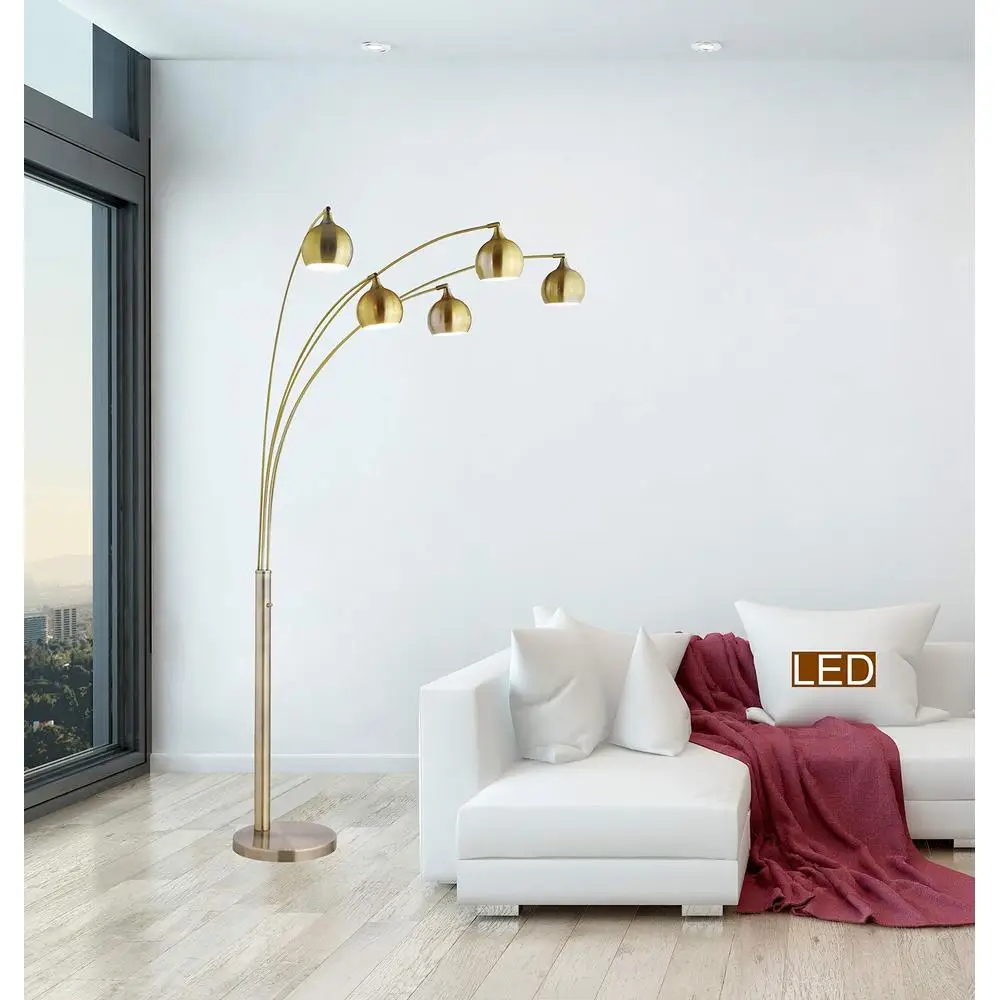
For truly statement-making design impact, 5-arm arc floor lamps create dramatic visual interest while offering maximum lighting versatility across diverse interior styles.
Material Considerations and Finishes
Material choices significantly impact both functionality and aesthetic integration:
Metal finishes create distinct effects—brass and gold tones add warmth and luxury; chrome and nickel provide sleek, contemporary sophistication; matte black offers dramatic contrast and modern edge. Consider how these finishes interact with existing metals in your space for cohesive design.
Shade materials dramatically affect light quality—fabric shades diffuse light softly and reduce glare; metal shades direct light more precisely and create dramatic shadows; glass shades offer clarity and brightness while maintaining visual lightness.
Durability considerations should influence material selection based on usage patterns. High-touch areas benefit from fingerprint-resistant finishes, while homes with children might prioritize stable designs with fewer delicate components.
Base materials add substantial visual weight to the design—marble bases provide stability and luxury but limited mobility; metal disc bases offer sleek profiles but may require additional weight for stability with multiple extended arms.
Mixing materials creates visual interest when done thoughtfully—the combination of metal, stone, glass, or wood elements within a single lamp design can tie together various materials already present in your interior.
For a particularly luxurious foundation that anchors these statement pieces, marble base arc floor lamps combine premium materials with sophisticated engineering for both stability and style.
Choosing the Right Multi-Arm Arc Lamp
Selecting the ideal multi-arm arc lamp requires evaluating several key criteria to ensure you’re investing in a fixture that will meet your specific needs while providing lasting value. Quality multi-arm lamps distinguish themselves through thoughtful engineering, premium materials, and attention to functional details.
Construction quality is paramount—look for smooth, stable joints that maintain position without drifting; seamless connections between components; and substantial weight that indicates quality materials rather than lightweight substitutes. Premium lamps feature precisely machined parts that align perfectly and operate smoothly even after years of adjustments.
Functional specifications directly impact versatility—check the maximum extension of each arm, height adjustability range, rotation capabilities of individual heads, and weight capacity of the adjustment mechanisms. These technical details determine how effectively the lamp will serve your specific lighting needs.
When considering investment value, remember that quality multi-arm lamps typically start around $200-$300, with premium options ranging from $500-$1,500 depending on materials, engineering sophistication, and brand reputation. While initial cost may exceed basic lighting options, the versatility and longevity of well-made fixtures provide excellent long-term value.
The lamp you select should align with your primary lighting requirements—whether that’s dramatic accent lighting for a design-focused space, functional task lighting for productive activities, or versatile ambient illumination for general living areas. This primary purpose should guide your selection process.
For comprehensive evaluation criteria, our top arc lamp features buying guide provides detailed insights into the technical and design elements that distinguish exceptional multi-arm lamps from average options.
Key Features to Prioritize
When evaluating multi-arm arc lamps, certain features significantly enhance functionality:
Independent arm controls represent perhaps the most important feature—look for models where each arm can be switched on/off separately and, ideally, dimmed individually. This capability dramatically increases versatility, allowing customized lighting scenarios impossible with single-switch designs.
Height adjustability features are valuable for adapting to different seating arrangements and activities. Some premium models offer telescoping mechanisms that allow vertical adjustment without changing the arm angles, while others include adjustable central poles that raise or lower the entire arm assembly.
Base stability is non-negotiable—look for weighted designs (typically 15-25 pounds or 7-11 kg) that prevent tipping even when arms are extended asymmetrically. Marble, heavy steel, or concrete bases generally provide the most reliable stability.
Tool-free adjustment mechanisms make daily use significantly more convenient. Quality lamps feature finger-tightened knobs or smooth friction joints that can be repositioned easily but maintain their set position reliably.
Material quality in moving parts directly impacts longevity—brass or steel mechanisms typically outlast aluminum or plastic components, particularly in joints that see frequent adjustment. Similarly, wiring should be generously sized and well-insulated to prevent degradation over time.
Understanding what to look for in an arc floor lamp helps ensure your investment delivers both the aesthetic impact and functional performance you expect.
Understanding Bulb Options and Light Quality
Bulb selection dramatically impacts both the functionality and atmosphere created by your multi-arm lamp:
LED options offer significant advantages for multi-arm applications, including lower heat output (important when adjusting arms), energy efficiency (particularly valuable when multiple lights operate simultaneously), and longer lifespan (reducing maintenance in hard-to-reach fixtures).
Color temperature selection fundamentally affects mood and function—warmer temperatures (2700K-3000K) create cozy, relaxing environments ideal for living rooms and bedrooms; neutral temperatures (3500K-4000K) support focus and productivity in work areas; cooler temperatures (5000K+) provide maximum clarity for detailed tasks.
Understanding brightness needs helps determine appropriate lumen output—for ambient lighting, approximately 400-600 lumens per arm creates pleasant general illumination; task lighting typically requires 700-900 lumens per arm for adequate detail visibility; accent lighting can be effective with as little as 300 lumens when precisely directed.
Dimming compatibility is essential for maximum versatility—ensure both the lamp’s internal circuitry and the selected bulbs support dimming. Some LED bulbs require specific dimmer types, so verify compatibility before purchasing.
Consider the advantages of both replaceable bulb designs (allowing easy updates as technology improves) and integrated LED systems (typically offering sleeker design and more consistent performance). Each approach has merits depending on your priorities.
Tips for Effective Multi-Arm Arc Lamp Usage
Maximizing the potential of your multi-arm arc lamp involves ongoing experimentation and thoughtful adjustments. Consider these practical tips for getting the most from your investment:
Regularly reposition arms to discover new lighting effects. Even subtle adjustments of 10-15 degrees can dramatically change how light interacts with your space. Set aside time monthly to experiment with new configurations that might better serve your evolving needs.
Create preset “lighting scenes” for different activities. Develop specific arm arrangements for reading, entertaining, watching movies, or everyday use. Once you’ve found optimal positions for each scenario, take photos for reference to easily recreate these arrangements.
Use dimming strategically throughout the day. Program brightness levels (or manually adjust) to complement natural light cycles—brighter illumination to energize morning activities, moderate brightness for afternoon productivity, and softer illumination for evening relaxation.
Balance your multi-arm lamp with other light sources. Rather than relying solely on your arc lamp, integrate its light with existing fixtures. The lamp might provide primary illumination in one zone while complementing ceiling lights in another area of the same room.
Maintain your lamp regularly for optimal performance. Dust lamp heads and bulbs monthly (when powered off and cool) to maintain maximum brightness. Periodically check and gently tighten adjustment knobs that may loosen with regular use.
Consider seasonal light adjustments. Reposition arms to complement changing natural light patterns throughout the year. Winter typically requires more upward-directed ambient light to compensate for decreased daylight, while summer may benefit from more focused task lighting as ambient natural light increases.
Can Multi-Arm Arc Lamps Replace All Other Room Lighting?
While multi-arm arc lamps provide exceptional versatility, they typically work best as part of a comprehensive lighting plan rather than as standalone solutions:
For smaller spaces (under 150 square feet or 14 square meters), a well-positioned multi-arm lamp can potentially serve as primary lighting, particularly models with 5+ arms that provide broad coverage. These spaces benefit from the lamp’s ability to direct light toward multiple areas simultaneously.
In medium to large rooms, multi-arm lamps excel as supplemental lighting that addresses specific needs while complementing existing ambient illumination from ceiling fixtures or recessed lighting. The combination provides more comprehensive coverage than either approach alone.
Light coverage sufficiency depends on room dimensions and lamp specifications. As a general guideline, each arm typically provides adequate illumination for approximately 30-40 square feet (3-4 square meters) when used for ambient lighting, less when providing focused task illumination.
The most effective lighting plans layer different fixture types, with multi-arm lamps playing a starring role but supported by other light sources. This layered approach provides greater flexibility for different activities and times of day than any single fixture can deliver alone.
How Do You Prevent Multi-Arm Lamps from Overwhelming Small Spaces?
Incorporating dramatic multi-arm lamps into smaller spaces requires thoughtful planning:
For visual balance in compact rooms, choose models with slimmer profiles and fewer arms (2-3 instead of 5+). The visual impact comes from the distinctive arching form rather than size or complexity, allowing smaller-scale versions to make similar design statements.
Position the lamp in a corner with arms extending inward rather than centrally placed. This approach preserves valuable floor space while allowing the dramatic arching forms to be fully appreciated without overwhelming the room.
Select appropriately scaled designs—lamps with arms extending 3-4 feet (90-120 cm) rather than 5-6 feet (150-180 cm) maintain proportional relationships with other furnishings in smaller rooms while providing similar functionality.
Incorporate mirrors or other reflective surfaces near the lamp to visually expand the space while maximizing the impact of the light. This technique creates the impression of greater spaciousness while enhancing illumination efficiency.
In extremely limited spaces, consider wall-mounted multi-arm fixtures that provide similar directional lighting versatility without requiring floor space. These alternatives deliver comparable functionality when traditional floor-standing options would be impractical.

